I’ve met very few teams that successfully found a valuable and useful way to update and use a Sprint Burndown. The Sprint Burndown can be tedious to update (if done manually), and doesn’t seem to trigger the discussions in the Scrum team it is designed for. Even to agree on a unit causes confusion (hours, tasks, finished User Stories?).

But don’t despair; let me introduce you to Confidence Smileys. Confidence Smileys provide a simple, honest, transparent and overview-friendly tool for the team to visualize how confident a team is that they will be able to finish each User Story by the end of the sprint. The can replace the need for a Sprint Brundown (or Sprint Burnup), or function as a complement.
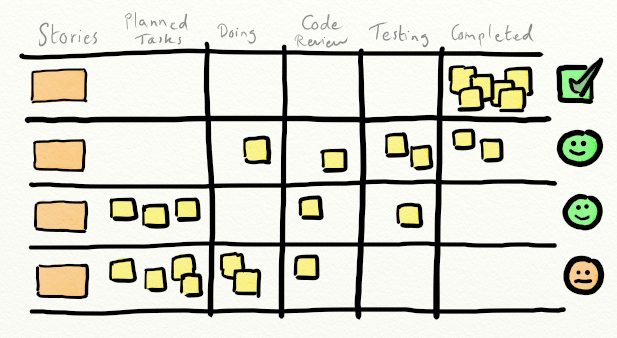
The idea first presented itself when working with a team at Spotify. It immediately became appreciated and popular, both by the team and by the Product Owner. Since then I’ve pitched the idea to many more teams, both directly and indirectly through friends and colleagues, many are still using it today.
It’s very simple. At the end of every daily meeting the team asks themselves how confident they are that they will be able to finish each User Story by the end of the sprint. The answer is represented by a Confidence Smiley.
The team quickly goes through each lane/User Story and updates the color of the Confidence Smiley. When in disagreement, you could let the most pessimistic vote wins.
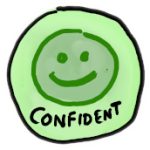 |
Happy/Green smiley = We are confident that we will be able to finish this story by the end of this sprint |
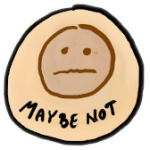 |
Nervous/Orange smiley = We will probably not be able to finish this story |
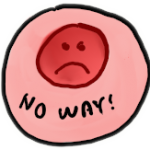 |
Sad/Red smiley = No way we will be able to finish this story |
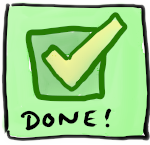 |
Green checkbox = User story is DONE. |
When a smiley shifts (from green to orange, or from orange to red) the team grabs the opportunity to discuss what they need to do, how they can help out, and if they need to alert Product Owners and Stakeholders on changes in the forecast.
A few examples of discussions that a change of a Confidence Smiley could trigger:
- What needs to happen for the Nervous (or Sad) smiley to become Confident? Can we make that happen?
- If we removed a User Story from the Sprint would that enable us to focus and finish the remaining?
- Can we slice the User Story and deliver a smaller increment?
- Which stakeholders do we need to alert on the change in the forecast?
Confidence Smileys offer an instant and simple overview of the sprint progress. Not only for the team but for anyone. It’s super easy to start using them and quicker and more informative than a Sprint Burndown.
Let go of the Sprint Burndown. Let it die.
Try something else.
Run an experiment with Confidence Smileys 🙂




While I very much like the self-reporting and action on change, one thing that a burndown/up chart does do is provide empirical data that acts as a counterweight to subjective bias.
Mature teams in an organisation that rewards transparency (and/or with a strong coach) should be OK, but otherwise you run the risk of describing how the team thinks things SHOULD be, not as how they ARE.
“In God We Trust – everyone else brings data” – Deming
I agree with you on that concern. For teams new to Scrum I would probably suggest them to do both a burndown and use these smileys.
Also, the smileys don’t provide historical data as a burndown do.
So, this is simply a tradition RAG status on the sprint dressed up as an ‘agile’ “thing” using smilies….SMH
Visually I guess they look super similar, but for me there are a couple of important differences. RAG is used by a project manager to report progress and deviations from a plan. Confidence smileys are used by the team itself to trigger discussions on how to help out with their short-terms goals of the sprint. The smileys don’t represent risk of deviations from plan, they represent how confident the team is that they will be able to accomplish the goal/user story before the end of the sprint. But perhaps you’re right, maybe I’m splitting hair.
I really like this Jimmy! Lets face it you don’t have to do a Burndown to figure out how many stories/number of points the team delivered in a sprint, you just count up at the end of the sprint. That way the team can still use their stories/points in a guide when sprint planning (as we are assuming scrum in your example).
I think this will help the team focus on making the brutally honest decisions that are sometimes needed on the spot to ensure they finish the sprint delivering the most value!
The reason for this is this approach means the team focus on a realistic story per story assessment of their own progress instead of focusing on a generic number which on its own doesn’t immediately prompt them or help them focus on tough trade off decisions.
Great idea. Surprisingly, Smileys convey lots of information. One concern for removing the burn down chart, is that, in the long run, it might undermine the planning phase.
It sounds like a good idea, but isn’t it even better to answer 1 important question during the Daily Stand up, and that is “Are we going to meet our Sprint Goal”? This can also mean that (part) of a user Story will not be delivered, if it doesn’t contribute to the Sprint goal (e.g. a user Story to fill up the sprint)?
It is more high-level, but maybe sufficient. What do you think?
Look, if a team gets to a point where they’ve outgrown the “laws” that govern Scrum, then so be it. This particular Ri team has metamorphosed into a new, exciting, Agile organism that feels a burndown is a step backward. I would applaud them for that.